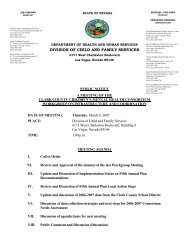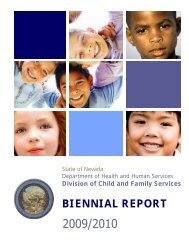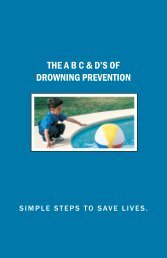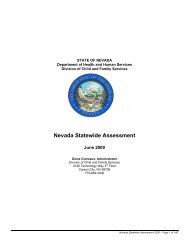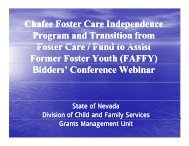STATE OF NEVADA - Division of Child and Family Services
STATE OF NEVADA - Division of Child and Family Services
STATE OF NEVADA - Division of Child and Family Services
You also want an ePaper? Increase the reach of your titles
YUMPU automatically turns print PDFs into web optimized ePapers that Google loves.
Systemic Factor E: Service Array <strong>and</strong> Resource Development<br />
Item 35: Array <strong>of</strong> services<br />
Goal: The State will ensure there is an array <strong>of</strong> services available that:<br />
• Assess the strengths <strong>and</strong> meets the needs <strong>of</strong> children <strong>and</strong> families,<br />
• Determine other service needs,<br />
• Address the needs <strong>of</strong> families in addition to individual children to create a safe home environment,<br />
• Enable children to remain safely with their parents when reasonable, <strong>and</strong><br />
• Help children in foster <strong>and</strong> adoptive placements achieve permanency.<br />
One objective under this item is that the State will seek out external sources <strong>of</strong> support (i.e. Technical Assistance) to<br />
improve the State’s service array. During 2009, the <strong>Division</strong> sought <strong>and</strong> received Technical Assistance from the National<br />
Resource Centers (NRC) regarding service array. The National Resource Center for Organizational Improvement<br />
(NRCOI) assisted Nevada with completion <strong>of</strong> Washoe County’s Service Array Assessment process. This assessment<br />
used the talents <strong>of</strong> nearly 40 members <strong>of</strong> the community, including the WCDSS Advisory Board Members. At this time,<br />
Washoe County has completed the process <strong>and</strong> the NRCOI indicated that this process was very effective. Several<br />
workgroups were convened to address the deficiencies found. These workgroups focused on the following three items:<br />
1) Enhancing the service Capacity <strong>of</strong> Families to Provide for Foster <strong>Child</strong>ren; 2) Meeting the Educational Needs <strong>of</strong> Foster<br />
<strong>Child</strong>ren; <strong>and</strong> 3) Meeting the Physical <strong>and</strong> Mental Health Needs <strong>of</strong> Foster <strong>Child</strong>ren. Despite the success in this review,<br />
implementation <strong>of</strong> these strategies will continue to present a challenge considering specific budget cuts <strong>and</strong> their impact<br />
on local community services. Next, the NRCOI will be working with the State to complete the process in the DCFS-Rural<br />
Region. The ongoing technical assistance received from the NRCOI has been instrumental to the success <strong>of</strong> this item.<br />
To reach the overall goals, the State has the primary objective <strong>of</strong> reviewing the effectiveness <strong>and</strong> level <strong>of</strong> sufficiency <strong>of</strong> the<br />
service array, including assessment <strong>of</strong> several key elements. These include: 1) Placing <strong>and</strong> maintaining children in safe<br />
environments; 2) Enabling children to remain home safely when reasonable; 3) Helping children in foster care <strong>and</strong><br />
adoptive homes achieve timely permanency; 4) Supporting adoptive families after placement <strong>and</strong> finalization; <strong>and</strong> 5)<br />
Helping youth prepare for independent living. Each <strong>of</strong> these areas will be addressed as separate sections below.<br />
<strong>Family</strong> Preservation <strong>Services</strong> (Title IV-B Subpart 2 <strong>Services</strong>):<br />
<strong>Family</strong> Preservation <strong>Services</strong> programs are characterized by high intensity, immediately accessible treatment <strong>and</strong><br />
ancillary services for at-risk children <strong>and</strong> families. The goals <strong>of</strong> <strong>Family</strong> Preservation <strong>Services</strong>’ programs are to reduce the<br />
risk <strong>of</strong> child abuse/neglect <strong>and</strong> thus eliminate unnecessary out-<strong>of</strong>-home placement <strong>of</strong> children <strong>and</strong> to strengthen the family<br />
to better care for the developmental needs <strong>of</strong> their children. Program staff provides crisis intervention, clinical<br />
assessment, <strong>and</strong> family preservation services to a protective services population in nine areas: Washoe County, Clark<br />
County, Carson City, Fallon, Wells, Pahrump, Mesquite, Elko <strong>and</strong> Ely.<br />
Clark County utilizes an array <strong>of</strong> prevention services to help children at risk <strong>of</strong> abuse <strong>and</strong> neglect to remain safely with<br />
their families. These services include flexible funding to support families in areas such as rent, utilities, apartment deposit,<br />
bus tokens, food vouchers <strong>and</strong> other basic needs, <strong>and</strong> contract services with community agencies. Drug court remains<br />
another option for families where substance abuse is a contributing factor to child abuse or neglect. Clark County<br />
maintains collaboration with community agencies, such as Safe House <strong>and</strong> Safe Nest, to provide services to high-risk<br />
families <strong>of</strong> domestic violence. Parent training classes are <strong>of</strong>fered through numerous community agencies, as well as<br />
through the Clark County Parenting Project.<br />
<strong>Family</strong> Preservation services in Washoe County include strength-based treatment utilizing pro-social adaptive behavior<br />
modification techniques to teach clients to change socially <strong>and</strong> personally maladaptive behavior; individual <strong>and</strong> group<br />
counseling to assist clients <strong>and</strong> their children to adopt strategies <strong>and</strong> behaviors that sustain recovery <strong>and</strong> maintain daily<br />
functioning including conflict resolution; couples <strong>and</strong> family therapy; supportive <strong>and</strong> instructive interventions to address life<br />
management needs; case management; assistance to families who were involved with or at-risk <strong>of</strong> becoming involved<br />
with child welfare agencies; assessments <strong>of</strong> strengths <strong>and</strong> needs <strong>of</strong> clients related to life <strong>and</strong> home management skills;<br />
development <strong>of</strong> individualized plans based on assessment results <strong>and</strong> client assistance in job seeking, resume<br />
development <strong>and</strong> application for employment.<br />
Community providers receiving IV-B funds are a primary source for pre-placement services for the DCFS Rural Region<br />
Nevada APSR – SFY 2010<br />
Page 60 <strong>of</strong> 108



